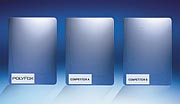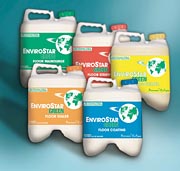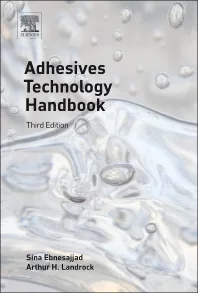New Technology Offers a Green Light to Develop Better Coatings

Similarly, when Pioneer Eclipse recently expanded its line of floor care products, it developed new formulas that would focus on meeting the strictest environmental standards - those enforced in most European countries - and that would provide significant improvements in floor coating appearance and durability.
Both companies used PolyFox(tm) fluorosurfactants, a group of patented fluoropolymers, to help them achieve their goals.
Developed by OMNOVA Solutions Inc., PolyFox is a new fluoropolymer technology platform based on oxetane chemistry that features short fluorinated side chains, stable ether linkages and reactive end group functionality. Unlike conventional, non-polymeric fluorosurfactants that are typically based on long C8F17 fluoroalkyl groups, PolyFox short-chain structures vary from only CF3 to C4 F9.
The polymeric structure of the fluorosurfactants offers performance benefits including improved wetting, flow and leveling, as well as stain- and scratch-resistance in some applications - while at the same time avoiding potential environmental problems caused by long chain fluorosurfactants.
The fluorosurfactants can be tailored to a variety of applications for producing component products such as reactive fluorinated intermediates and customized coatings modifiers, as well as formulated high-performance coatings in collaboration with coatings manufacturers.
"PolyFox is changing the industry paradigm in fluorosurfactants," said Joe Twitchell, head of PolyFox market development, "and we're seeing a lot of commercial interest in it in the short time it has been available, since late last year.
"Widespread interest has come from manufacturers of industrial coatings, automotive paints, wood coatings, electronics cleaners and coatings, floor care products and specialty emulsions," he said.
The technology platform uses oxetane chemistry with a fluorinated side-chain substituent on the oxetane ring (see Figure 1). This unusual design was developed in the early 1990s for aerospace and defense purposes by Aerojet-General, a subsidiary of GenCorp, OMNOVA's former parent company. This discovery would be viewed as having excellent potential as an anti-fouling release agent in marine coatings to prevent barnacles from sticking to the bottoms of ships. Later it was discovered that when PolyFox was incorporated at additive levels, it would improve stain resistance in solventborne coatings for vinyl wallcoverings and other proprietary products manufactured by OMNOVA. With each new application, R&D scientists explored the tremendous flexibility of this technology.
"We found that we were able to easily tailor the fluoroalkyl chain length for a wide variety of commercial applications," said Dr. Barry Rosenbaum, OMNOVA director of corporate technology. Most exciting was the recognition of the technology's strength as a fluorosurfactant. PolyFox began to be commercialized as a polymeric wetting, flow, leveling and low-foaming agent for the floor polish market, an application the company already served with a line of styrene acrylic polymers.
The timing couldn't have been better for a high-performing fluorosurfactant that is also environmentally preferable, because certain long-chain fluorosurfactant products have been withdrawn from coatings markets and others have been coming under increasing scrutiny by the EPA in a time of rising environmental concern.

The Long and Short of It
The PolyFox line of fluorosurfactants is designed to address the EPA's concerns with long perfluoroalkyl-containing, small molecular compounds while maintaining the accepted performance characteristics of typical C8F17-based products. The fluorosurfactants are based on a platform of poly (oxetane) polymers where the length of the pendant perfluoroalkyl group is C4F9 or shorter (CF3,C2F5 or C3F7).
Their macromolecular structure makes them less bio-available than typical small molecule fluorosurfactants and the use of short perfluoroalkyl chains provides compounds that are generally believed to be non-bioaccumulative (see Figure 2).

"In fact, we're rapidly expanding surface science," said Richard Thomas, PolyFox principal scientist. "We're learning and documenting more every day about the inherent structure-property relationships that determine surfactant performance in formulated coatings."
"Our growing knowledge base on how fluorosurfactants work is helping speed the practical application of PolyFox," said Rosenbaum, "and it's a key reason why coatings manufacturers are looking to work with us in formulating new coatings products.

(Left)A PolyFox solution shows only slight, non-persistent foaming. (Right) Two prominent, long-chain competitive fluorosurfactants in solution display excessive foaming.
Most long-chain additives provide a single benefit while also incurring compromising drawbacks. PolyFox fluorosurfactants have been engineered to avoid these problems. For example, they exhibit low interfacial elasticities owing to their branched structure and thus have very little tendency to foam. If slight foaming is present, it does not persist long enough to introduce a defect in most coating systems. Many long-chain, small-molecule fluorosurfactants create unbreakable, persistent foams that complicate formulation and application. This incurs the need to add defoamers to a formulation, resulting in added cost and more complicated formulas (see Figure 4).

The coating using PolyFox PF-156A waterborne fluorosurfactant (left) demonstrates a superior, smooth surface vs. the cratered surfaces on the middle and right panels using long-chain fluorosurfactants.

Commercialization through Collaboration with Coatings Manufacturers
"The proof is in the pudding - in the ability of two companies to adapt the full potential of PolyFox in formulating new paradigm coatings that exhibit improved surface appearance, application performance and environmental acceptability," said Joe Twitchell. "When a coatings manufacturer makes this kind of commitment, he wants to be sure that using new materials, such as new generation fluorosurfactants, will help deliver all these benefits - and will mitigate risks of environmental problems and potential product concerns downstream."We've got a very robust collaborative program working with a range of coatings manufacturers to use PolyFox in their products," he added.
Tnemec is a good example of this kind of new product development. The 83-year-old manufacturer of high-performance coatings for concrete and structural steel applications is currently completing the development of three new coatings using PolyFox PF-636 solventborne fluorosurfactant.
"We're in the process of finalizing the formulation of this series of products, a concrete floor coating, a maintenance paint primer and a maintenance paint topcoat," said Yves Floriot, the Tnemec chemist who is driving this project.
"These are products that are targeted typically for demanding exterior applications," said Remi Briand, Tnemec vice president of R&D. "We look to PolyFox as an agent to offer improved flow and leveling and to facilitate good re-coating application."
Tnemec is also currently testing PolyFox PF-636 for four other products under development, part of a company initiative to upgrade product technology to increase sales and strengthen its leadership position in key specialty markets. "We're moving from lower solids to higher solids generally," said Mark Thomas, product marketing manager, "and we want to offer products that meet all customer criteria for performance, durability and environmental suitability."
Pioneer Eclipse, a leader in floor-care products, equipment and maintenance programs, is developing new products from the ground up to lead the market - not simply react to current environmental issues.
"As we started planning green products about three years ago, we recognized that there is no national standard in the U.S. to use as a guidepost - every state has different regulations," said Dr. Robert Allen, Pioneer Eclipse marketing manager. "So looking to the future and long-term market leadership, we elected to develop new formulas that would meet the world's strictest standards, those used in most European countries."
This meant eliminating (or minimizing) compounds like zinc, ethylene glycol ethers, phosphates and preservatives, and selecting a fluorosurfactant that would also be environmentally friendlier.
"From a technology standpoint, we want to develop products that are superior in every way - performance, value and refreshingly green," he said. "In that process, we need to be sure that all our raw materials contribute to this goal.
"From the standpoint of our user customers, they want floor care products that make floors look clean and attractive - and keep looking that way. That's especially important in supermarkets, restaurants, schools and hospitals," he said.
PolyFox is being used in two of the five-product systems - the floor finish and sealer. It has proven to provide the desired performance as a wetting agent and allows for easy application of multiple coats.
"As far as we know, it's also the only fluorosurfactant available today that fits the Euro environmental model," Allen said.

Expanding to Meet Growing Customer Demands
OMNOVA has been adding products to the PolyFox line to satisfy requests from diverse coatings manufacturers. Currently the line consists of 11 products in three categories: waterborne, solventborne and radiation curable."We're expanding the technology with the addition of both anionic and non-ionic products, for example to provide users with more choices of solubility, fluorochemical surface organization and surface tension," Twitchell said. "These products are enabled by the tailoring of the polymer backbone and the end group functionality as well as polymer architecture control, which allows the precise balancing of molecular weight, molecular area demand and the resultant surface tension and solubility characteristics.
"This enriched platform easily allows the production of random copolymer structures and controlled architecture block copolymers," he added.
More new editions are forthcoming. A next generation of aqueous, solvent and reactive fluorosurfactants will be announced in the near future.
For more information, contact JP.PolyFox@Omnova.com.
Looking for a reprint of this article?
From high-res PDFs to custom plaques, order your copy today!





